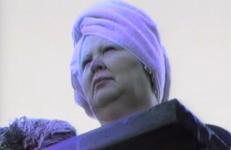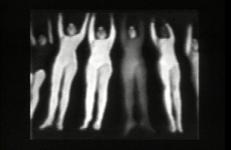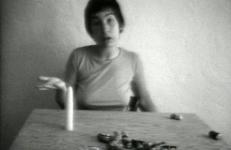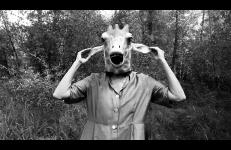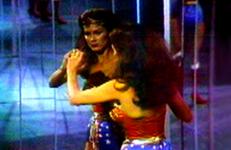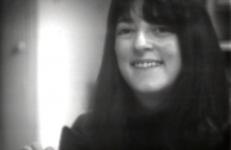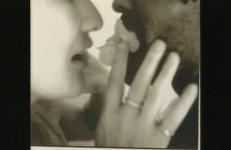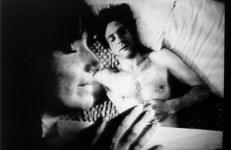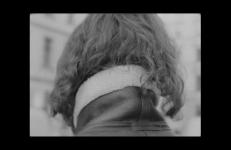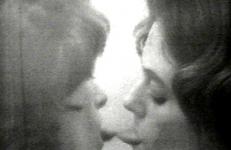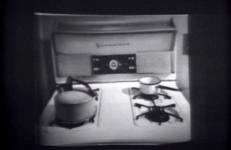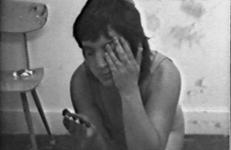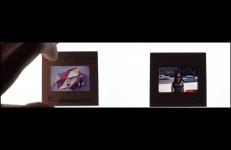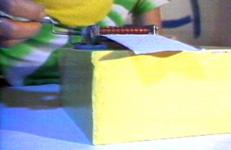This classic feminist tape deviates from David Byrne’s and Jonathan Demme’s popular 1980s versions of suburban life, True Stories. Rather than poking sarcastic fun at the woman locked in the split-level, Suburban Queen poignantly evokes a daughter’s longings. Portraying the relationship of a mother and daughter inextricably bound yet puzzled by each other’s lives, Faber recounts her frustration with her mother’s depression and passivity, and her fantasy of how her mother might transcend these conditions.
Feminism
Invoking Eve’s temptation and fall from grace with recurring images of the garden, the serpent, and the apple, Condit provides a look at the trouble beneath the surface in a modern-day suburban paradise. As a housewife struggling to come to terms with the conflicting demands placed on her as a wife, mother, career-woman, and daughter, Anne finds she is divided against herself; her identity is a territory occupied by everyone’s needs but her own.
“Nobody likes you if they think you’re rude- you better act the way you should.” But we didn’t.
Telling it the way it was lived, Susan Mogul’s short film captures the energy, passion and radical spirit of the Los Angeles Woman’s Building (1973-1991), a groundbreaking center for women’s culture.
Based on accounts of girlhood anorexia, Swallow unravels the masked and shifting symptoms that define clinical depression. With a densely layered soundtrack, humorous and painful scenes of potential psychological breakdown reveal a critical loss of meaning, and the failure to diagnose mental illness. Weaving narrative, documentary, and experimental strategies, Swallow intimately traces the awkward steps from unacknowledged depression to self-recognition.
Child uses the soap opera format to play with the structure and expectations of the family melodrama. Following the melodramatic format that “if it can happen, it will happen,” coincidence and unlikely events abound in Swamp’s gleeful send-up of lurid intrigue, threatened morality, and endless double-crosses. With looped and repeated edits, fast-paced action, and aggressively funky video effects, Child layers on artifice and excess in an overdone remake of the TV serial.
Nancy Cain interviews an upside down chin face about Women's Liberation, asking "Where do you stand on the subject?" The chin face professes to be happy with her lot, and says she enjoys living alone with her cat.
This video was shot in the Prince Street, New York loft/studio used by the Videofreex.
"I made Take Off in my studio apartment on Myra Avenue during my second year living in Los Angeles. As a member of the Feminist Studio Workshop, I was writing an essay at the time comparing male artists’ representations of their sexuality with female artists’. Vito Acconci was my model for a male perspective. I had been captivated by his videotapes; particularly Undertone, where he was supposed to be masturbating while seated at a table. The videotape was my ultimate response and commentary on Acconci as well as an expression of my own sexuality."
— Susan Mogul
Tales of a Future Past is a video about a giraffe and a zebra who fight over an undefined baby creature, in hopes of making it one of their own species. Using toy masks and a sparse theatricality, Cecelia Condit creates a contemporary reflection on species extinction and the lonely, silent world that will ensue from it.
A stutter-step progression of "extended moments" unmasks the technological "miracle" of Wonder Woman's transformation, playing psychological transformation off of television product.
Tell Me About Your Mother investigates matrilineal lineage, domesticity and creativity. Intimate and conversational, seven female artist friends and colleagues of mine—mostly boomers—recount their mother’s creative influence upon them. Additionally, each woman discusses the unique way(s) she distinguished herself from her mother.
In April 1974, Video Data Bank co-founders Lyn Blumenthal and Kate Horsfield conducted their first interview, an in-depth conversation with art historian and curator Marcia Tucker. During the remainder of that year, Blumenthal and Horsfield went on to interview four more notable art world women: Joan Mitchell, Lucy Lippard, Agnes Martin and Ree Morton.
This tape was originally an installation at the Whitney Museum of American Art, part of which included the video collaboration Channels of Desire. Recreating coin-operated porno booths, Channels aired one photo image on seven TVs, interrupted only by the viewer inserting a coin and choosing a segment. The concept behind it was the construction of desire in categorical ways, the form of the piece speaking to sexual desire as something that is constantly evading the viewer. The images present women’s experiences with interracial, lesbian, and heterosexual encounters.
This video was originally an installation at the Whitney Museum of American Art, part of which included the video collaboration Channels of Desire. Recreating coin-operated porno booths, Channels aired one photo image on seven TVs, interrupted only by the viewer inserting a coin and choosing a segment. The concept behind it was the construction of desire in categorical ways, the form of the piece speaking to sexual desire as something that is constantly evading the viewer. The images present women’s experiences with interracial, lesbian, and heterosexual encounters.
Begun as a consideration of the upgrading from manual to digital film editing techniques, Transitional Objects explores the anxiety and loss inevitable in such a transition while also suggesting the consequences of other life transitions. The video takes its title from D.W. Winnicott's theory of children's use of transitional objects to negotiate the gaps between internal reality and the shared reality of people and things.
Adapted from a performance by the same name, this courageous video fuses autobiographical material with information about how an alcoholic family perpetuates addictive behavior. Elements of Alcoholics Anonymous meetings, such as the “Hi, my name is...” introduction are used along with photo-montage and a disjointed narrative. In addition to being shown at venues such as the Museum of Modern Art and the New Museum, Trick Or Drink has been used regularly by hospitals and alcohol treatment centers throughout the United States.
In 1959, Jean Seberg stares into Raoul Coutard’s 35mm camera lens and then turns – the closing frame of Godard’s Breathless is the back of her head. For the film it is a closing. For her character it is less clear. Is it a refusal? A denial? A shying away from? An admission of guilt or not caring? A disappearing act? In 2017 on the streets of Berlin, twenty-three women, friends and passersby, reverse Seberg’s action.
In her oft-cited essay “Video: The Aesthetics of Narcissism,” Rosalind Krauss says, “self-encapsulation — taking the body or psyche as its own surround — is everywhere to be found in the corpus of video art” (October 1, Spring 1976). This certainly applies to this early work of Hermine Freed. Utilizing a split and reversed screen, Freed faces herself, caressing and kissing her doubled image.
This feature-length experimental narrative, about women’s relationships to new reproduction technologies and genetic engineering, combines documentary interviews with field experts and a science fiction segment depicting stories of in-vitro fertilization and other methods. Underexposed: The Temple Of The Fetus examines ways the news media shapes perceptions and social attitudes towards medical topics.
Each year, more women undergo treatment at hospital emergency surgical services as a result of family violence than rapes, muggings, and car wrecks combined. This startling statistic is the basis for a series of site-specific installations on domestic violence, On The Edge Of Time. Underground, the first installation for the Pittsburgh Three Rivers Art Festival, used three wrecked cars strewn along a 180-foot section of railroad track to reference the history of Abolition and the Underground Railroad, and as metaphors for different aspects of abuse.
Holt's terrain is her Aunt Ethel's home in New Bedford, Massachusetts, presented in still images and excerpts from letters to the artist from her aunt. Holt pays particular attention to her aunt's poignant story of aging, altering the images by "underscanning" them—a technical process that compresses the edges of the video image—building an intrinsic limitation into the tape: the compression of time and personal history represented by the images and narrative. This process echoes Holt's reading, slightly distorting and compressing the information in the letters as she presents them.
Amidst growing discussions on the headscarf issue, the President of Turkey was holding the annual Republic Day Ball at the Presidential Palace. For the reception he sent one-person invitations to the members of the Parliament whose majority was held by the Islamic Democrats. This was his strategy to prevent their wives, who would naturally wear headscarves, from attending the night. I was outraged by this conservative secularism and wanted to express my personal protest, embodying the stress on the contemporary Islamic body. --Köken Ergun
"An eye-opening piece of guerilla counter-surveillance, Untitled documents Dinçel’s time working as a tech assistant at a film festival where they managed to record the headset chatter between themselves and the two male projectionists working the event. Over the course of 12 short minutes, we hear the men continually berate Dinçel, ignoring their specific knowledge of film and dismissing them when they correctly diagnose technical problems."
- Michael Sicinski (from Cleo a Journal of Film and Feminism)
I moved three thousand miles from the east coast to join the feminist art program at CAL ARTS in 1973. I had only been in LA three weeks when Judy Chicago took us to a "Menstruation" art exhibition at Womanspace Gallery. The exhibit included every conceivable medium about menstruation - paintings, weavings, sculpture. I was amazed - nothing was taboo. Being outrageous was normal in this LA feminist art environment. Around the same time I read "Female Eunuch" by Germaine Greer. She wrote, and I paraphrase, "If you taste your blood when you scratch your fin
This project started with an email from a stranger in 2017. The sender was the widower of the late artist Tania and he invited the filmmaker to look at her “archive.” Tania was born to Jewish parents in Poland in 1920. The family moved to Paris in the 1930s, but during the WWII they fed to Montreal, then emigrated to New York. Tania eventually became an artist. While facing many hurdles as a female artist in the 1960s and 70s, Tania vigorously created a wide range of artworks, not only paintings and three-dimensional pieces, but also public art projects.
“[This tape] gives a clear picture of the consistency of Jonas’s concerns. The performance was based upon the merging of two fairy tales — The Frog Prince told backward and The Boy Who Went Out To Learn Fear told forward. These two tales become intertwined into a single text whose transformations are effected through fragmentation, demonstrating a process “unhitched” from time, as free from the laws of physics as are the fairy-tale sources. “




